Getting Started
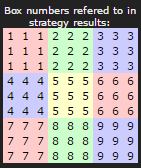
The convention on this site is to refer to columns with numbers, rows with letters (I is skipped since it looks like 1 and we use J). Box numbers may not be so obvious, so to the right is a plan of them). There is also a Glossary of terms.
Last Remaining Cell in a Box
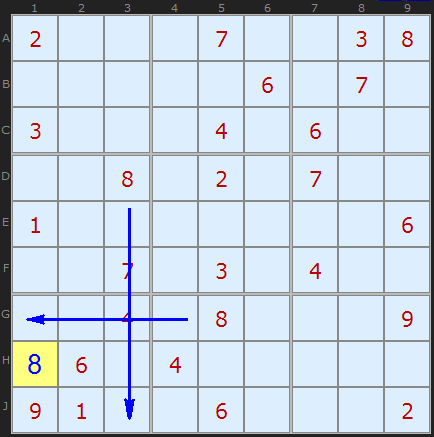
So the last remaining cell in box 7 for an 8 is H1.
Last Remaining Cell in a Row (or Column)
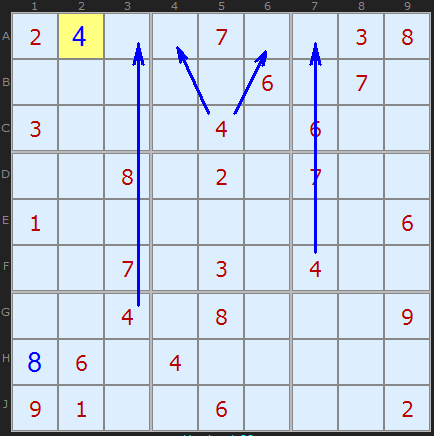
So the last remaining cell for 4 in the row is A2.
Pinned!
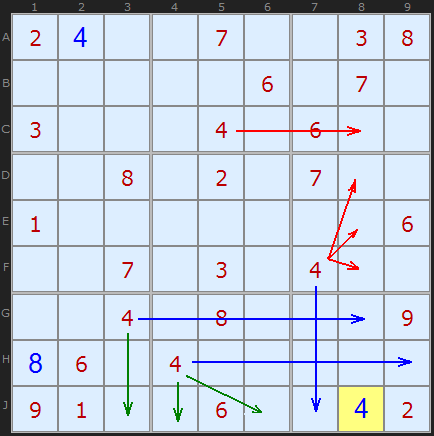
Sometimes there are several reasons for a placement. This 4 in J8 is a great example. In blue I have shown that 4 in J8 is the last remaining number in terms of the box it is in. The red + blue lines show it is the last number in column 8 and the green + blue lines demonstrate it is the last number in row J.
This 4 has been pinned to the board quite conclusively.
The Last Possible Number
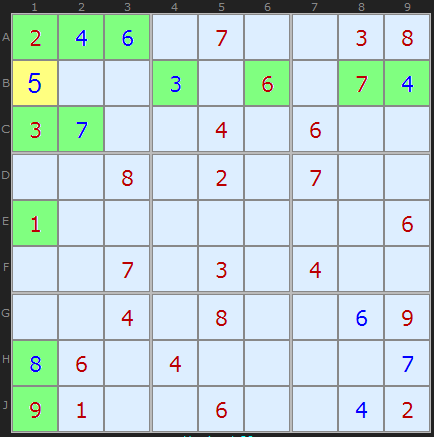
Eyeballing is actually quicker than checking each cell for the last possible number, but it is a valid approach, so I include it here. It is the sort of strategy a beginner thinks of when faced with the puzzle for the first time. It is best used when a cell stands out because all the other numbers seem to be in place.
Here the 5 in B1 can be determined because every other number from 1 to 9 apart from 5 is present in either the row, column or box (marked in green).
In the jargon, this is a Naked Single - if you were using candidates at this stage it would be the only candidate in the cell. The 'eyeballing' techniques help determine Hidden Singles since other candidates are possible in those places but at least one candidate is unique to a particular row, column and box. You can see this difference if you 'Take Step' with candidates turned on.

Comments
Email addresses are never displayed, but they are required to confirm your comments. When you enter your name and email address, you'll be sent a link to confirm your comment. Line breaks and paragraphs are automatically converted - no need to use <p> or <br> tags.
... by: peter
... by: Romeo
... by: STS
This is how squares in a chessboard are named.
... by: STS
This is how squares in a chessboard are named.
... by: Paul
... by: wrsides
... by: Thyge
... by: pcw
... by: jb681131
... by: George
... by: james reinoso
el ejemplo que muestran por que en B1 va el 5 por favor expliquenmelo
En la columna 1 están el1-8-9 con lo cual solo queda como posible el 5.
... by: chebob
... by: Satish Gupta
... by: Danis
1 LOOK BEFORE YOU LEAP. check to see if there is any other number that can fit in a box before you write one in.
2 PENCIL IN POSSIBILITIES. write very faintly what numbers can fit in a box. (eg if there is 3 possible numbers then write them in the real small, and then when you put one of those numbers in that row/column/large box, simply cross it out) eventually you'll have 1 nubemr penciled in, and that MUST be the number that goes there.
3 DOUBLE CHECK, DOUBLE CHECK, DOUBLE CHECK. need I say more?
Hope that helps. (step 2 seems to be the most affective)
... by: edmark
... by: Huskidawgs-
... by: Mike
I got bord with the Jumble so I moved on to the
celebrity cipher and mastered that one .My brother got me started with Sudoku and its really a
challenge .Just started it last week. I think the eyeballing is a good way to start. great web
site, keep up the good work.
Mike
... by: Anon
... by: Amir Latif
It may not always work, and often you may have to do some manual testing.
Please tell me that other people are using this device which came to me.
Blessings, Amir
... by: cliff
brain teaser
... by: ly ousmane
... by: Satish Gupta